Of all the joyous surprises of the trail — a cold can of beer bobbing in a stream, a group of day hikers with food to spare, a wonderful view at the top of a stiff ascent — perhaps no pleasure compares to finding a steaming, private hot spring.
Why do hot springs and hiking go so well together? Is it the chance to finally get clean, to soak away the soreness? Or is it the realization that nature sometimes provides us, unexpectedly, comforts that exceed her challenges?
To get you started on a winter of contented soaking, we've assembled a list of five trailside hot springs. Some are rustic and remote, some are developed, but all of them offer a delightful respite after a long day on the trail.
Share your own favorites below.
Hot Springs to See
Name: Valley View Hot Springs
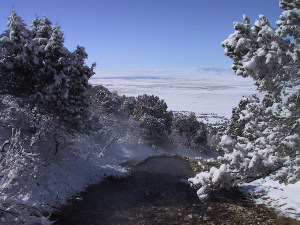
Top pool of Valley View hot springs, Colorado
(Photo: Orient Valley Land Trust)
Type: Developed
Location: Near Villa Grove, Colorado
Description: Nestled in the foothills of the Sangre de Cristo Mountains near Crestone, Colo., Valley View Hot Springs is on land owned and managed by the nonprofit Orient Valley Land Trust. With plentiful camping, cabins, and several developed pools, Valley View is an ideal basecamp for hikes in the Sangre de Cristos or in the nearby Great Sand Dunes National Park.
From the lower developed pools, a series of undeveloped ponds ascend into the foothills, each one slightly hotter, more scenic, and remote than the last. The top-most pool offers wonderful solitude. Valley View also has trails and a cave with the largest bat colony in Colorado!
Note: Valley View is clothing optional and the Orient Valley Land Trust charges a modest fee for access.
More Information: Orient Valley Land Trust
Name: Conundrum Creek Hot Springs
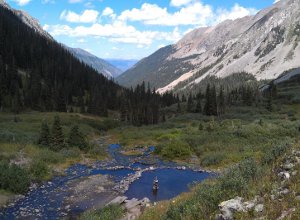
Conundrum Creek Hot Springs, Colorado
(Photo: USDA Forest Service)
Type: Undeveloped
Location: Maroon Bells-Snowmass Wilderness of the White River National Forest, Colorado
Description: Located at the base of the spectacular 14,000'+ Maroon Bells peaks, this warm springs offers incredible views, silence, and contemplation. This spring is approximately nine miles into the backcountry on the Conundrum Creek Trail, a challenging trail in a designated wilderness area.
Evan Pletcher, Forest Service employee, says "it's a pretty amazing place, though it's crowded in the summer. I like going in the fall, but if you're prepared to deal with snow and the possibility of avalanches, you can head up in late spring too. The water is 100 to 105 degrees — nice and warm!"
Note: Due to the popularity of the area, the Forest Service asks visitors to follow all posted regulations and strict Leave No Trace Ethics.
More Info: White River National Forest
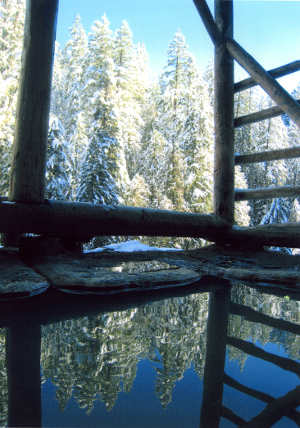
Umpqua/Toketee Hot Springs
(Photo: USDA Forest Service)
Name: Umpqua/Toketee Hot Springs
Type: Semi-developed
Location: Hot Springs Segment of the North Umpqua Trail, in Umpqua National Forest, Oregon
Description: Just a few miles from the Toketee Lake Trail head, a .3-mile side trail leads to a small covered structure that covers the 108-degree Umpqua Hot Springs, also known as Toketee Hot Springs. This small covered pool provides a wonderful respite for hikers traversing the 80-mile North Umpqua Trail.
The nearby Toketee Lake Campground offers swimming, fishing, and developed camping for those who would rather visit the Umpqua Hot Springs on a day hike.
According to Katina Verardo, Forest Service volunteer, "the hike in is very easy, and a new bridge makes it even better. There are four pools and the main pool is covered with a little shelter."
More Info: Umpqua National Forest, (541) 957-3200
Name: Hot Springs
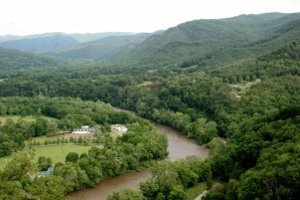
Arial view of Hot Springs, N.C.
(Photo: Karl Gustavson)
Type: Fully developed
Location: Hot Springs, North Carolina
Description: The hot springs in Hot Springs, N.C., are right next to the trail, but they aren't rustic. Instead, two local businesses, the homey Broadwing Farm and the more developed Hot Springs Resort and Spa, provide access to the local waters, which are not only warm, but also lightly carbonated.
The Appalachian Trail winds through the center of town, and the famous views from Max Patch bald mountain are approximately 20 trail miles north. There are plenty of accommodations in town, but seasoned hikers will appreciate Elmer's Sunnybank Inn, a cozy eccentric place with great rates and all-you-can-eat vegetarian food.
More Info: www.hotspringsnc.org
Name: Alvord Hot Springs
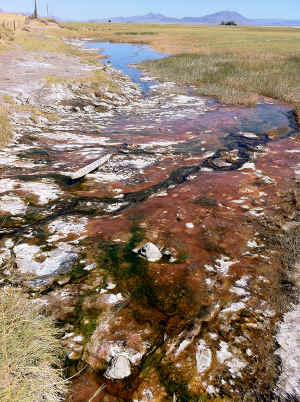
Alvord Hot Springs, Oregon
(Photo: Mike Sisk/Wikimedia Commons)
Type: Semi-developed
Location: Private lands adjacent to Steens Mountain Cooperative Management and Protection Area, near Frenchglen, Ore.
Description: Near the base of the 10,000'+ foot Steens Mountain, on a broad expanse of playa, Alvord Hot Springs offer true isolation and scenic beauty. These primitive, sulfur-rich springs offer views of herds of wild horses, the towering Steens Mountain, and some of the darkest sky in North America.
After a day hiking around Wildhorse Lake or running up Little Blitzen Gorge, Alvord Hot Springs is an exotic and isolated place to soak. According to Mike Kelly, BLM Outdoor Recreation Planner, "the springs are located on private lands, and the owner allows folks to visit. The tubs are very unimproved. Primitive camping is available on BLM lands nearby."
Note: This spring is located on private land, and not regularly maintained.
Tips for Safe Soaking
Hot springs are large pools fed by water warmed deep in the Earth's crust. Though soaking in natural springs is usually safe, it does present some real risks.
Here are some tips to minimize the risks and maximize the enjoyment of your soak.
Bring a friend
Enjoying the blissful solitude of a hot spring can be great, but a little company can enliven the experience immeasurably. Hot, deep water can present hazards of its own, and a friend is valuable backup in the unlikely event of an accident.
Hydrate
Hot springs can easily exceed 120 degrees Fahrenheit and, because you're submerged, you might not realize how much you're sweating. Combined with the exertions of your hike, this creates a risk for dehydration. Even minor dehydration can cause muscle soreness, which is precisely what many people go to hot springs to avoid. Alcohol is a diuretic and can accelerate dehydration, so overindulging, tempting though it might be, is not a good idea. Bring ample cold water in a sealed bottle and sip often.
Be aware of heat
Undeveloped hot springs vary widely in temperature. What may appear to be a tranquil pool could be a boiling mass of superheated water hot enough cause serious burns. More worrisome, some hot springs (particularly those near tectonically active areas like Yellowstone National Park) can vary in temperature from day to day and even from hour to hour.
During my visit to Hobo hot springs in Saratoga, Wyo., the water was pleasantly warn when I first entered, but after a few minutes, a hot plume of water surged in. Instantly, I was sweating, and leaped out of the pool, much to the amusement of several older locals, who remained submerged to the neck the whole time. For this reason, I avoid undeveloped hot springs without a history of use, and check the temperature of the spring with a candy thermometer before taking the plunge.
Be aware of cold
Marinating in hot water on a freezing day is a unique pleasure, but just because the water's warm, doesn't exempt you from the risk of cold air. Ears and noses can get dangerously cold, despite the hot steam. Pack a warm hat that you don't mind getting damp, and don't be shy about wearing it while soaking.
Don't slip
In the winter, a thick layer of ice can surround hot springs. In the summer, warm overflow from hot springs encourages the growth of slippery biofilm and algae. Both surfaces are extremely slick, so exercise extreme caution with your footing around hot springs.
Be hygienic
Some hot springs can host dangerous bacteria or fungi. People with open cuts or sores, or who have suppressed immune systems, would be well advised to avoid hot springs for this reason.
Though it might seem excessive, it's an important courtesy to other hot spring users to pre-wash before your dip. No one wants to marinate in days' worth of a stranger's trail-dust. So take your bandanna and a bottle filled with warm water 200 feet downhill and rinse off the worst of your muck, sunscreen, and bug dope before entering the springs.
Hot springs water can contain dangerous levels of heavy metals, or alkali minerals, so an "instant" cup of hot tea or Ramen right out of the spring is a bad idea.
Seek out known springs
The risks of scalds, falls, and odd bacteria can outweigh the rewards of being the first in a spring. Contact local hiking clubs, land management agencies, and outfitters for the safest and best hot springs to visit.
Unconvinced of the potential dangers of hot springs? Check out this delightful public service announcement from the Nevada Bureau of Land Management.
We know we didn't cover all the hot spots above. This is where you come in.
Do you have a favorite trailside hot spring? Tell us about it.

 by Seth Levy
by Seth Levy









